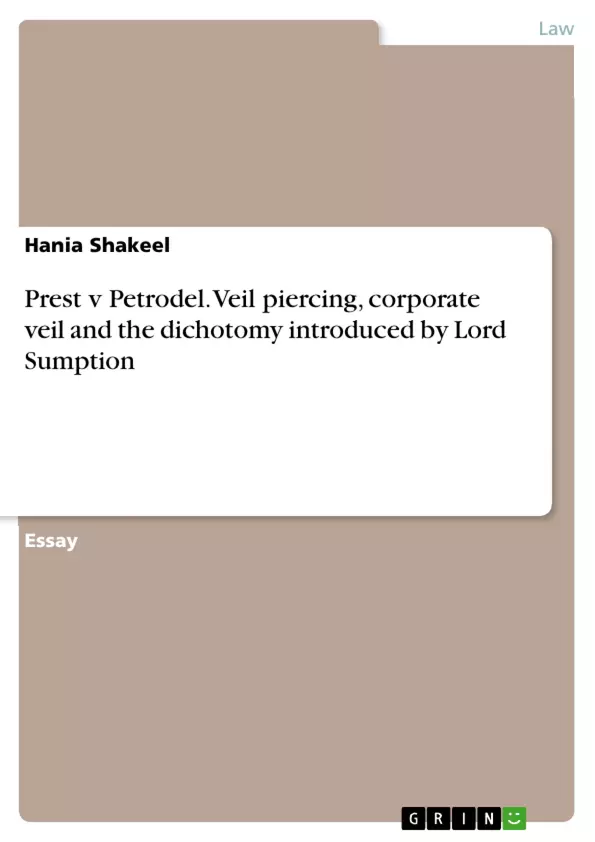This essay will examine the area of corporate piercing after the leading UK company law decision of the UK Supreme Court "Prest v Petrodel Resources Ltd". With the support of case-laws and the commentary by critics, it will be demonstrated that besides Prests’ efforts, it has failed in its’ aims of providing clarity to the law. The following arguments will be discussed: veil piercing as the remedy of last resort and corporate veil is just a label of an existent principle. Furthermore, the dichotomy introduced by Lord Sumption in evasion and concealment, with support of case laws.
Inhaltsverzeichnis (Table of Contents)
- The veil piercing as the remedy of last resort
- Corporate veil is just a label of an existent principle
- The dichotomy introduced by Lord Sumption in evasion and concealment
Zielsetzung und Themenschwerpunkte (Objectives and Key Themes)
This essay aims to analyze the area of corporate piercing in English law, particularly in the context of the Prest v Petrodel case. It will examine how the judgment in Prest has impacted the clarity of the law and explore the difficulties in applying the principle of piercing the corporate veil.
- Piercing the corporate veil as a remedy of last resort
- The nature of the corporate veil as a principle
- The distinction between evasion and concealment in veil piercing
- The lack of judicial consensus on the rationale of Prest
- The impact of Prest on the clarity of the law
Zusammenfassung der Kapitel (Chapter Summaries)
- This chapter explores the concept of piercing the corporate veil as a remedy of last resort. It examines the arguments of critics who suggest that this principle is applied inconsistently and that the use of other legal mechanisms would often be more appropriate. The chapter also discusses the case of Ben Hashem, where the court held that a company can be a facade even if it was not originally incorporated with deceptive intent.
- This chapter focuses on the debate surrounding the corporate veil as a principle. It examines Lord Walker's argument that "piercing the veil" is merely a label, indicating cases where courts impose liability on company controllers based on statutory provisions or common law grounds. The chapter also explores the use of concealment and evasion principles as alternatives to veil piercing, highlighting the difficulties in applying these distinctions in practice.
- This chapter investigates the dichotomy between evasion and concealment introduced by Lord Sumption. It discusses the criticisms that this distinction has unnecessarily complicated the law and dissected over 80 years of case law. The chapter examines the distinction between "evasion" cases, where the separate legal personality of a company is used to defeat or frustrate a right, and "concealment" cases, where the corporate veil needs to be "lifted" to identify the real actors.
Schlüsselwörter (Keywords)
This essay focuses on the core concepts of corporate piercing, corporate veil, Prest v Petrodel, evasion, concealment, remedy of last resort, judicial consensus, case law, legal principles, and the application of English law. It delves into the ongoing debate surrounding the clarity and effectiveness of the corporate veil doctrine in light of the Prest judgment.
- Quote paper
- Hania Shakeel (Author), 2022, Prest v Petrodel. Veil piercing, corporate veil and the dichotomy introduced by Lord Sumption, Munich, GRIN Verlag, https://www.grin.com/document/1195195



